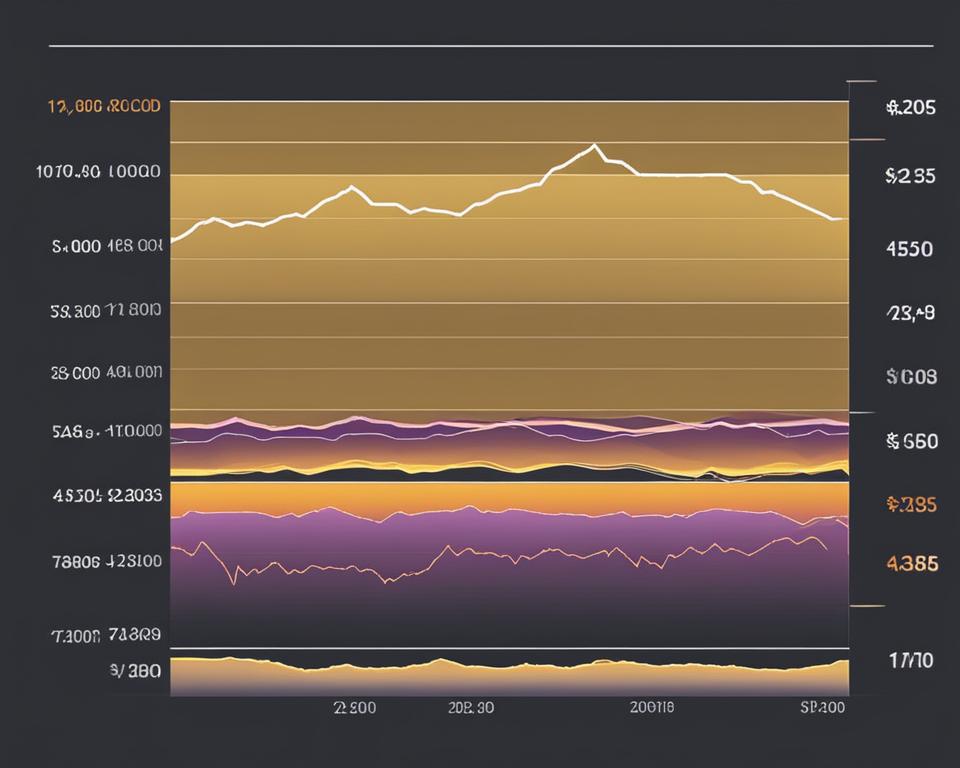Are you considering precious metal investing? Exploring gold investment opportunities or silver investment options? Investing in gold can be an attractive option for diversifying your portfolio and potentially protecting your wealth.
Gold has a long history of being seen as a valuable asset and has been used as a form of currency for centuries.
When it comes to investing in gold, there are different methods to consider. You can buy physical gold such as coins or bullion, invest in gold miners and associated companies, or purchase gold through exchange-traded funds (ETFs). Each approach has its own advantages and considerations.
Investing in gold is often seen as a way to diversify your portfolio. Gold is not correlated with traditional assets like stocks, bonds, or real estate, making it an attractive option for reducing overall investment risk. It can provide stability and act as a potential hedge against inflation and economic uncertainty.
However, it’s important to understand that investing in gold also comes with risks. Gold does not generate income or offer high returns like other investments. The price of gold can fluctuate due to various factors, including currency movements, market sentiment, and supply and demand dynamics. Additionally, holding physical gold may involve costs for storage and insurance.
Key Takeaways:
- Diversifying your investment portfolio with gold can help reduce risk.
- Gold can act as a potential hedge against inflation and economic uncertainty.
- Investing in gold comes with costs and risks that should be considered.
- There are different methods to invest in gold, including physical gold, gold mining companies, and gold ETFs.
- Before investing in gold, carefully assess your investment goals and risk tolerance.
The Historical Significance of Gold
Gold has played a significant role in human civilization for thousands of years, serving as a form of currency and a symbol of wealth. Its history dates back to around 560 B.C., when merchants sought a universally recognized and easily transferable form of money. This led to the creation of gold coins, which became standardized currency across different regions.
Throughout history, gold’s importance grew, with various civilizations recognizing its intrinsic value. In Europe and Asia, gold became a symbol of wealth and power, used for trade, jewelry, and religious rituals. Its durability and scarcity made it highly coveted, leading to its adoption as a medium of exchange.
“Gold is a sign of wealth, and every wealthy person has gold.” – King Solomon
In 1792, the United States officially adopted a bimetallic standard, with both gold and silver being legal tender. This system helped establish a stable monetary framework during the early years of the country. However, as the world became more interconnected, nations began to shift towards the gold standard, where the value of currency was directly tied to a fixed amount of gold.
The gold standard reached its peak during the late 19th and early 20th centuries, with many countries using gold as the basis for their monetary systems. It provided stability and consistency, ensuring that currency had tangible value backed by gold reserves.
“Gold is money. Everything else is credit.” – John Pierpont Morgan
However, the gold standard eventually faced challenges, especially during times of economic crisis. To combat the Great Depression in the 1930s, some countries temporarily abandoned the gold standard and devalued their currency. The global financial system experienced further changes, and the gold standard was officially abandoned by the United States in 1971.
Despite the shift away from the gold standard, the historical significance of gold as a currency and store of value remains. Its enduring allure highlights its timeless appeal as an investment and a hedge against economic uncertainty.
The Rise of Gold Coins
The creation of gold coins played a pivotal role in establishing gold as a standardized currency. Merchants sought a form of money that was widely accepted and easy to exchange. Gold, being highly divisible and resistant to corrosion, emerged as the ideal medium of exchange.
Gold coins became a common currency across different civilizations, allowing for seamless trade and fostering economic growth. They provided a sense of trust and predictability, as the value of the coins was determined by their gold content.
| Civilization | Significance of Gold Coins |
|---|---|
| Ancient Greece | Gold coins facilitated trade among city-states and created a stable monetary system. |
| Roman Empire | Gold coins were used as a means of payment for goods and services, and their widespread acceptance contributed to the empire’s economic prosperity. |
| Islamic Caliphates | Gold dinars became the standard currency of the Islamic world, facilitating trade and establishing a stable economic system. |
| Ming Dynasty (China) | During the Ming Dynasty, gold coins were widely accepted and regulated by the imperial government, ensuring economic stability. |
Gold as a Hedge Against Inflation and Economic Uncertainty
Gold has long been regarded as a reliable hedge against inflation and economic uncertainty. When inflation rates rise, the value of traditional currencies can erode, leading investors to turn to alternative assets. Gold, with its limited supply and intrinsic value, has historically proven to be an effective store of wealth in times of inflation.
Furthermore, gold is often seen as a safe haven asset during periods of geopolitical unrest. In times of political and economic uncertainty, investors flock to gold as a means of protecting their wealth. The precious metal has a reputation for preserving value and acting as a shield against market volatility.
“Gold is the ultimate safe haven asset, sought after by investors during times of crisis and uncertainty.”
– John Hathaway, Senior Managing Director at Tocqueville Asset Management
Gold’s ability to act as a hedge against inflation and economic uncertainty can be attributed to several factors. Unlike paper currencies, gold is a tangible asset that cannot be printed or manipulated by central banks. As a result, it maintains its value over time and serves as a reliable store of wealth.
During periods of inflation, when the purchasing power of currencies declines, gold tends to appreciate in value. This makes it an attractive investment option for investors looking to protect their wealth from the erosive effects of inflation.
Additionally, gold’s status as a safe haven asset stems from its historical performance during times of geopolitical unrest. Wars, political conflicts, and economic crises often lead to increased demand for gold as investors seek stability and a means of preserving their wealth.
The Role of Gold in Diversified Portfolios
Gold plays a crucial role in diversified investment portfolios as it has a low correlation with other asset classes such as stocks and bonds. This lack of correlation means that gold prices often move independently of other investments, providing additional diversification benefits.
When global financial markets experience volatility and economic uncertainty, the value of gold tends to rise. This inverse relationship with traditional assets can help offset losses in other parts of the portfolio, contributing to overall risk reduction.
Therefore, including gold as part of a well-diversified investment strategy can provide investors with a measure of security and stability. By allocating a portion of their portfolio to gold, investors can potentially mitigate downside risks and enhance overall portfolio performance.
| Gold | Stocks | Bonds | Real Estate | |
|---|---|---|---|---|
| Average Annual Return (2000-2020) | 10.4% | 6.8% | 4.5% | 7.2% |
| Standard Deviation (2000-2020) | 13.7% | 14.7% | 4.3% | 10.2% |
| Correlation with Gold | 0.15 | -0.06 | 0.21 |
Note: The data above represents historical averages and correlations and is not indicative of future performance.
As illustrated in the table above, gold has exhibited a higher average annual return and lower volatility compared to stocks and real estate over the past two decades. Additionally, gold’s correlation with other asset classes is relatively low, further supporting its role as a diversifying investment.
In conclusion, gold’s ability to act as a hedge against inflation and economic uncertainty, coupled with its diversification benefits, make it an attractive asset for investors. Whether used to protect wealth during times of inflation or provide stability in turbulent markets, gold has proven its worth as a safe haven investment.
Investing in Gold for Portfolio Diversification
Gold is a valuable asset for portfolio diversification, offering stability and a hedge against market volatility. As one of the oldest and most trusted forms of investment, gold has a reputation for safeguarding wealth and preserving purchasing power. Incorporating gold into your portfolio can provide diversification benefits, reducing overall losses and minimizing risk exposure.
Diversification with Gold
Gold is an ideal diversifying investment due to its low correlation with traditional assets such as stocks, bonds, and real estate. While these assets may fluctuate in value based on market conditions, gold often remains stable or appreciates, providing a counterbalance to market movements. By including gold in your investment portfolio, you can add a layer of protection and potentially increase overall returns.
Gold as a Diversifying Investment
The unique characteristics of gold make it an attractive option for diversification. Unlike paper assets, gold is a tangible asset with intrinsic value that is not subject to the same risks associated with currency fluctuations or economic downturns. Its scarcity and historical significance contribute to its allure as a safe-haven investment.
“Gold has shown the ability to maintain its value over time and has been known to outperform other assets during times of economic uncertainty or geopolitical unrest.”
Gold and Asset Allocation
When considering asset allocation, gold can play a vital role in balancing risk and reward. Including gold in your portfolio can help offset the volatility of other investments, reducing the impact of market downturns. It provides a potential hedge against inflation and can serve as a store of value in times of economic uncertainty.

Whether it is in the form of physical gold, gold ETFs, or gold mining stocks, adding gold to your investment strategy can enhance portfolio diversification and help protect your wealth.
Gold as a Dividend-Paying Asset
Gold stocks present an appealing opportunity for growth investors looking for higher returns compared to physical gold. Not only do these stocks have the potential for capital appreciation, but they also offer the added benefit of dividends. Investing in dividend-paying gold stocks can provide a steady stream of income while potentially delivering a higher return on investment.
One key advantage of dividend-paying gold stocks is their ability to generate profits even when the price of gold is down. Unlike physical gold, which relies solely on price appreciation to generate returns, gold mining companies have the potential to earn profits from their operations. This means that investors can earn dividends even in a bearish gold market, enhancing the overall return on their investment.
When considering dividend-paying gold stocks, it’s crucial to assess the historical dividend performance of the companies in question. Look for companies that have a strong track record of consistently paying dividends to their shareholders. This not only demonstrates the financial stability and profitability of the company but also provides a reliable income stream for investors.
“Investing in dividend-paying gold stocks can be an effective way to gain exposure to the gold mining sector while generating income through dividends.” – [Your Name]
However, it’s important to note that the gold mining sector, including gold extraction companies, can experience significant volatility. The performance of these stocks is influenced by various factors such as gold prices, production costs, geopolitical events, and industry trends. Therefore, thorough research and careful analysis are essential to make informed investment decisions in the gold mining sector.
To provide a comprehensive overview of dividend-paying gold stocks, the following table highlights some key factors to consider when evaluating potential investments in the gold mining sector:
| Company Name | Dividend Yield | Dividend Payout Ratio | Historical Dividend Growth |
|---|---|---|---|
| Company A | 2.5% | 40% | 10% annually |
| Company B | 3.2% | 50% | 5% annually |
| Company C | 1.8% | 30% | 8% annually |
| Company D | 4.1% | 60% | 12% annually |
This table provides a snapshot of different dividend-paying gold stocks, showcasing their dividend yield, payout ratio, and historical dividend growth. These factors can help investors assess the income potential and sustainability of dividends in the gold mining sector. However, it’s important to note that this is just one tool in the overall analysis process, and further research and due diligence are necessary.
Investing in dividend-paying gold stocks can be an attractive proposition for investors seeking income-generation and potential capital appreciation within the gold mining sector. By evaluating companies with a strong dividend track record and carefully assessing the risks associated with the gold mining industry, investors can position themselves to benefit from the potential returns and income offered by dividend-paying gold stocks.
Different Ways of Owning Gold
When it comes to investing in gold, there are several different options available to you. Each method has its own advantages and considerations, allowing you to choose the option that best aligns with your investment goals and risk tolerance. Here are some of the most popular ways to own gold:
Owning Physical Gold
One of the most straightforward ways to invest in gold is by owning physical gold, such as gold coins or bars. These tangible assets allow you to have direct ownership of the metal and can be stored securely. However, keep in mind that there may be storage and insurance costs associated with holding physical gold.
Investing in Gold Mining Companies
Another way to gain exposure to gold is by investing in gold mining companies. These companies explore, develop, and produce gold, offering potential opportunities for growth and dividends. However, investing in individual gold companies carries its own risks, such as operational challenges and fluctuations in gold prices.
Purchasing Gold through ETFs or Mutual Funds
For investors seeking a more diversified approach, gold can be purchased through exchange-traded funds (ETFs) or mutual funds. These investment vehicles pool money from multiple investors to invest in a portfolio of gold-related assets. This method offers ease of trading and allows you to indirectly own gold without the need for physical storage.
Engaging in Gold Futures Contracts
A more advanced investment option is trading gold futures contracts. Gold futures are agreements to buy or sell a specific amount of gold at a predetermined price and date in the future. This method can provide opportunities for speculative trading or hedging against price fluctuations. However, it requires a deeper understanding of the futures market and carries higher risks.
| Investment Option | Advantages | Considerations |
|---|---|---|
| Owning Physical Gold |
|
|
| Investing in Gold Mining Companies |
|
|
| Purchasing Gold through ETFs or Mutual Funds |
|
|
| Engaging in Gold Futures Contracts |
|
|
Each method of owning gold has its own set of advantages and considerations. It’s important to carefully evaluate your investment goals, risk tolerance, and investment knowledge before deciding on the best gold investment option for you.
Investing in Gold During Times of Inflation
When inflation rates rise, investing in gold can be a wise strategy to protect your wealth. Gold has long been considered a safe-haven asset that tends to appreciate during periods of high inflation. As the purchasing power of traditional currency erodes, demand for gold increases as investors look for a reliable store of value.
Historically, gold has acted as a hedge against inflation, providing a tangible asset that retains its worth even as paper currency depreciates. The price of gold typically rises in response to inflationary pressures, offering investors an opportunity to maintain and grow their wealth.
The Role of Gold During High Inflation
During times of high inflation, investors often turn to gold as a means of preserving their purchasing power. The upward trajectory of gold prices can offset the negative impact of inflation on other financial assets, offering a degree of protection and stability.
Investing in gold during inflation can also provide diversification benefits for your portfolio. As gold is not directly correlated with traditional financial instruments such as stocks and bonds, its performance tends to be independent of broader market trends. This makes gold an attractive option for reducing overall portfolio risk.
“Gold has a unique ability to protect against inflation. It has maintained its value over centuries, providing investors with a reliable hedge during times of economic uncertainty.”
Moreover, gold has a long history of acting as a safe-haven asset during periods of economic turmoil and geopolitical unrest. Its intrinsic value and global recognition make it a sought-after asset when traditional markets experience volatility.
Strategies for Investing in Gold During Inflation
There are several strategies you can consider when investing in gold during inflation:
- Physical Gold: Purchasing physical gold in the form of coins, bars, or bullion allows you to directly own and possess the precious metal.
- Gold ETFs: Exchange-traded funds (ETFs) offer a convenient way to gain exposure to gold without the need for physical ownership.
- Gold Mining Stocks: Investing in gold mining companies can provide indirect exposure to gold prices and potential dividend income.
It’s essential to evaluate your investment goals, risk tolerance, and the specific market conditions before deciding on the appropriate strategy for investing in gold during inflation. Consulting with a financial advisor can help you make informed decisions tailored to your financial objectives.
An Overview of Gold Price Movements During Inflation
The price of gold tends to respond positively to inflation due to its historical role as a hedge against eroding currency values. As inflation rates rise, the demand for gold increases, driving up its price. The following table illustrates the performance of gold during periods of high inflation:
| Period | Inflation Rate | Gold Price Performance |
|---|---|---|
| 1970s | 7.7% (annual average) | 135% increase |
| 2008-2011 | 2.1% to 3.8% (annual average) | 143% increase |
| 2020-2021 | 2.3% to 5.0% (annual average) | 35% increase (as of June 2021) |
It’s important to note that gold price movements can vary based on various factors, including market conditions, economic indicators, and global events.
Gold as a Safe Investment and Store of Value
When it comes to investing, gold is often regarded as a safe haven and a store of value. Its enduring allure has stood the test of time, preserving wealth for generations. This precious metal has a long history of stability, making it an attractive addition to retirement portfolios.
One way to incorporate gold into retirement savings is through Gold IRAs, allowing investors to include precious metals as part of their retirement accounts. This not only diversifies the portfolio but also provides a safeguard against market fluctuations and economic uncertainties.
Gold’s reputation as a safe investment is built on its consistent performance during turbulent times. When traditional investments like stocks and bonds falter, gold has proven to be a reliable asset. Its intrinsic value remains intact, offering stability and peace of mind for retirement planning.
Furthermore, gold’s liquidity makes it an attractive option for those looking for a safe investment. Unlike certain assets that may require time and effort to convert into cash, gold can be easily bought or sold, providing flexibility for retirement planning needs.
With gold’s historical track record as a store of value and its inherent stability, it has become a popular choice for individuals seeking a secure investment for their retirement years.
Benefits of Gold as a Safe Investment and Store of Value:
- Preserves wealth and acts as a hedge against inflation
- Provides stability and diversification in retirement portfolios
- Offers liquidity and ease of buying and selling
- Proven track record of performance during economic uncertainties
“Gold is the money of kings, silver is the money of gentlemen, barter is the money of peasants, and debt is the money of slaves.” – Norm Franz
Gold’s enduring appeal as a safe investment and a store of value has made it a trusted asset class for retirement planning. By including gold in your portfolio, you can protect your wealth and secure a financially stable future.
Risks and Considerations of Investing in Gold
Investing in gold can be an attractive option for many investors seeking stability and protection in their portfolios. However, it is essential to understand the risks and considerations associated with investing in this precious metal.
Low-Return Investment
Gold is not an income-producing asset and does not offer high returns. Unlike stocks or real estate, gold does not generate regular dividends or rental income. Instead, its value primarily relies on price appreciation. While gold can provide a hedge against inflation and economic uncertainty, it is important to note that it tends to deliver relatively lower returns compared to other investment options.
Price Volatility: Influential Factors
The price of gold can be influenced by various factors, including economic indicators, geopolitical events, and supply and demand dynamics. Gold prices can fluctuate significantly in response to market conditions and investor sentiment. The world economy, central bank policies, and currency exchange rates can impact the demand for gold, potentially leading to substantial price swings. Therefore, investors should be prepared for potential price volatility when considering gold as an investment.
Storage and Insurance Costs
When investing in physical gold, one of the key considerations is the cost of storage and insurance. Storing gold securely can be expensive, especially for larger quantities. Investors often choose to store their gold in specialized vaults or secure facilities, which may involve recurring charges. Additionally, insuring gold against loss or theft is crucial but adds further costs. These ongoing expenses should be taken into account when evaluating the viability of investing in physical gold.
| Risks of Investing in Gold | Considerations |
|---|---|
| Low-income potential |
|
| Price volatility |
|
| Storage and insurance costs |
|
Despite the risks and considerations, gold can still serve as a valuable component of a well-diversified investment portfolio. Its potential as a safe-haven asset and a hedge against inflation offers a measure of stability and security. However, investors should carefully evaluate their investment goals, risk tolerance, and financial circumstances before deciding to invest in gold.
Gold Price Fluctuations and Market Volatility
Gold prices are subject to fluctuations and market volatility, influenced by several key factors including the value of the U.S. dollar, market sentiment, and industrial demand. Understanding the dynamics behind these fluctuations is crucial for investors looking to navigate the gold market.
One significant factor impacting gold prices is the inverse relationship it shares with the U.S. dollar. When the value of the dollar weakens, gold prices tend to rise. This is because gold is often viewed as a hedge against inflation, and as the dollar depreciates, investors turn to gold to protect the value of their assets.
Moreover, the limited supply of gold and its industrial applications also play a role in price fluctuations. Gold is a finite resource, and its scarcity contributes to its value. Additionally, industries such as jewelry, electronics, and dentistry rely on gold, creating demand that can affect its price.
While the gold market is generally more stable compared to other markets, it is not immune to price fluctuations and market volatility. Factors such as geopolitical events, economic indicators, and shifts in investor sentiment can lead to rapid changes in gold prices.
It is important for investors to closely monitor these factors and stay informed to make well-informed investment decisions in the gold market. Understanding the dynamics of gold price volatility and the various factors influencing gold prices can help investors anticipate market movements and adjust their investment strategies accordingly.
| Factors Influencing Gold Prices | Gold Market Fluctuations |
|---|---|
|
|
By closely monitoring these factors and staying informed about gold price volatility, investors can position themselves to take advantage of potential opportunities in the gold market.

When to Invest in Gold: Timing Considerations
The decision of when to invest in gold depends on various factors, including economic conditions, geopolitical unrest, and personal investment goals. Gold is often seen as a good investment during times of economic uncertainty and inflation. Geopolitical tensions can also drive up demand for gold. Investors should assess their individual circumstances, market outlook, and the impact of external factors before making an investment decision.
Factors to Consider
- Economic Conditions: When the economy is facing uncertainty or experiencing inflation, it may be an opportune time to invest in gold. The value of gold tends to appreciate during periods of economic instability, making it a potential hedge against inflation.
- Geopolitical Unrest: Political tensions and conflicts can lead to market volatility and increased demand for safe-haven assets like gold. Investing in gold during periods of geopolitical unrest can provide a sense of stability and protection for your portfolio.
- Personal Investment Goals: Your investment goals, risk tolerance, and time horizon should also influence your decision to invest in gold. Consider how gold aligns with your overall investment strategy and the role it plays in diversifying your portfolio.
By carefully considering these factors and conducting thorough research, you can make an informed decision about when to invest in gold. Remember that gold is just one component of a diversified investment portfolio, and it is crucial to maintain a balanced approach to investment.
“Gold is often seen as a safe-haven asset during times of economic uncertainty and geopolitical unrest.”
Ultimately, the decision to invest in gold should be based on a combination of factors, including economic indicators, market conditions, and your individual financial situation. Consulting with a financial advisor can provide valuable insights and guidance tailored to your specific needs and goals.
| Considerations | Benefits | Risks |
|---|---|---|
| Economic uncertainty | – Potential hedge against inflation – Preserves value during downturns |
– Low returns compared to other investments – Market volatility |
| Geopolitical unrest | – Safe-haven asset – Increased demand during crises |
– Price fluctuations – Depends on global events |
| Personal investment goals | – Portfolio diversification – Potential stability in volatile markets |
– Storage and insurance costs – Lack of income generation |
Conclusion
Investing in gold can be a valuable addition to your well-diversified investment portfolio. By including gold, you can achieve diversification, potential protection against inflation, and a safe-haven asset during economic downturns.
However, it is important to carefully consider the risks and costs associated with investing in gold. Like any investment, gold comes with its own set of challenges and considerations. Make sure to assess if it aligns with your investment goals and risk tolerance before making any decisions.
Seeking advice from a financial advisor is highly recommended. They can provide you with valuable guidance on the best precious metal investment strategies that are tailored to your specific needs. With their expertise, you can navigate the intricacies of the precious metal market and make informed investment decisions with confidence.
FAQ
Is investing in gold a good idea?
Investing in gold can be a beneficial addition to a well-diversified investment portfolio. It provides diversification, potential protection against inflation, and acts as a safe-haven asset during economic downturns. However, investors should carefully consider the risks and costs associated with investing in gold and determine if it aligns with their investment goals and risk tolerance.
What is the historical significance of gold?
Gold has been valued by civilizations for thousands of years and served as a form of currency. It started to act as a standardized currency around 560 B.C. Gold’s importance grew throughout Europe and Asia, with various civilizations using gold as a symbol of wealth. The United States adopted a bimetallic standard in 1792 but eventually abandoned the gold standard in 1971.
How does gold act as a hedge against inflation and economic uncertainty?
Gold is often seen as a hedge against inflation and economic uncertainty. When inflation rises, gold tends to appreciate. It is also considered a safe-haven asset during times of geopolitical unrest. Gold has historically preserved wealth and served as a store of value. It can provide downside protection in portfolios and is an asset class that can perform well during market downturns.
How can investing in gold diversify a portfolio?
Gold is seen as a diversifying investment that can add stability to a portfolio. It is not correlated with stocks, bonds, or real estate, making it an attractive option for diversification. By including gold in a well-diversified portfolio, investors can reduce overall losses and minimize risk exposure. Gold’s price stability and long-term value retention make it a valuable asset for diversification.
What are the advantages of investing in gold stocks?
Gold stocks can be appealing to growth investors and can provide higher returns than physical gold. Some gold mining companies are profitable even when the price of gold is down. Investing in gold stocks that demonstrate a historically strong dividend performance can provide income and potentially higher ROI compared to physical gold. The mining sector, including gold extraction companies, can experience high volatility.
What are the different ways of owning gold?
There are multiple ways to invest in gold, including owning physical gold such as gold coins or bars, investing in gold mining companies, and purchasing gold through ETFs or mutual funds. Gold futures are also a popular investment option. Each method has its own advantages and considerations, and investors should choose the option that aligns with their investment goals and risk tolerance.
Is gold a good investment during periods of high inflation?
Gold is often considered a good investment during periods of high inflation. When inflation rates rise, the price of gold tends to appreciate. Demand for gold increases as investors seek a safe-haven asset that can preserve purchasing power. Historically, gold has been a hedge against inflation, and during times of high inflation, investors may consider increasing their allocations to gold.
How is gold seen as a safe investment and a store of value?
Gold is seen as a safe investment and a store of value. It has preserved wealth throughout generations and can be a valuable addition to retirement portfolios. Gold IRAs allow investors to include precious metals in their retirement accounts. Gold’s price stability and liquidity make it attractive for those looking for a safe investment option.
What are the risks and considerations of investing in gold?
Like any investment, there are risks involved in investing in gold. Gold is not an income-producing asset and does not offer high returns. It is considered a low-risk, safe-haven investment. Gold prices can be influenced by various factors, including economic indicators, geopolitical events, and supply and demand dynamics. Storage and insurance costs should also be taken into consideration when investing in physical gold.
What factors can cause gold price fluctuations and market volatility?
The price of gold can fluctuate due to various factors, including the value of the U.S. dollar, market sentiment, and industrial demand. Gold has an inverse relationship with the dollar, and when the dollar weakens, gold prices tend to rise. The limited supply of gold and its industrial applications can also impact its price. The gold market is typically more stable compared to other markets but is not immune to price fluctuations and market volatility.
When is the best time to invest in gold?
The decision of when to invest in gold depends on various factors, including economic conditions, geopolitical unrest, and personal investment goals. Gold is often seen as a good investment during times of economic uncertainty and inflation. Geopolitical tensions can also drive up demand for gold. Investors should assess their individual circumstances, market outlook, and the impact of external factors before making an investment decision.
What is the conclusion regarding investing in precious metals?
Investing in gold can be a beneficial addition to a well-diversified investment portfolio. It provides diversification, potential protection against inflation, and acts as a safe-haven asset during economic downturns. However, investors should carefully consider the risks and costs associated with investing in gold and determine if it aligns with their investment goals and risk tolerance. Seeking advice from a financial advisor can provide valuable guidance on the best precious metal investment strategies.





